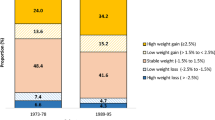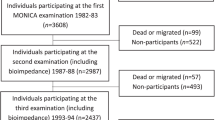Abstract
Background: Body mass index (BMI) differs by socio-demographic variables, but the origin of these associations remains relatively unknown.
Objective: To investigate the association between socio-demographic variables and the subsequent change in BMI over six years.
Design: A Dutch prospective cohort study (GLOBE) from which data were used from initially 20–49-year-old subjects (males: n=362; females: n=405). BMI was calculated from self-reported body height and weight data obtained in 1991 and 1997. Socio-demographic variables used were sex, age, educational level and the occupational level of the main breadwinner, family income, marital status, religious affiliation and degree of urbanization and measured in 1991.
Results: Cross-sectionally, BMI was higher in males than in females. BMI was positively associated with age and negatively associated with educational level in both sexes, after adjustment for the other socio-demographic variables. A positive association of BMI with family income was found in males and a negative association with occupational level was found in females. During follow-up, BMI increased significantly more in females (from 23.0 (s.d. 3.3) to 24.2 (s.d. 3.8)) than in males (from 24.3 (s.d. 2.9) to 25.1 (s.d. 3.5)). With the exception of a significant lesser increase in BMI in initially 30–39-year-old women compared to initially 40–49-year-old women, no other statistically significant associations were found between socio-demographic variables and the 6-year change in BMI.
Conclusions: Cross-sectional differences in BMI by socio-demographic variables are not due to different 6-year changes in BMI for categories of these variables in adulthood. Cross-sectional differences in BMI by educational level are probably established at the end of adolescence.
This is a preview of subscription content, access via your institution
Access options
Subscribe to this journal
Receive 12 print issues and online access
$259.00 per year
only $21.58 per issue
Buy this article
- Purchase on Springer Link
- Instant access to full article PDF
Prices may be subject to local taxes which are calculated during checkout


Similar content being viewed by others

References
Hubert HB, Feinleib M, McNamara PM, Castelli WP . Obesity as an independent risk factor for cardiovascular disease: a 26-year follow-up of participants in the Framingham Heart Study Circulation 1983 67: 968–977.
Manson JE, Colditz GA, Stampfer MJ, Willett WC, Rosner B, Monson RR, Speizer FE, Hennekens CH . A prospective study of obesity and risk of coronary heart disease in women New Engl J Med 1990 322: 882–889.
Willett WC, Manson JE, Stampfer MJ, Colditz GA, Rosner B, Speizer FE, Hennekens CH . Weight, weight change, and coronary heart disease in women. Risk within the normal weight range JAMA 1995 273: 461–465.
Feskens EJM, Kromhout D . Cardiovascular risk factor and the 25 year incidence of diabetes mellitus in middle-aged men: the Zutphen Study Am J Epidemiol 1989 130: 1101–1108.
Feskens EJM . Nutritional factors and the etiology of non-insulin dependent diabetes mellitus: an epidemiological overview World Rev Nutr Diet 1992 69: 1–39.
Kuskowska-Wolk A, Bergström R . Trends in body mass index and prevalence of obesity in Swedish women J Epidemiol Comm Health 1993 47: 195–199.
Kuczmarski RJ, Flegal KM, Campbell SM, Johnson CL . Increasing prevalence of overweight among US adults. The National Health and Nutrition Examination Surveys 1960 to 1991 JAMA 1994 272: 205–211.
Seidell JC, Verschuren WMM, Kromhout D . Prevalence and trends of obesity in The Netherlands 1987–1991 Int J Obesity Relat Metab Disord 1995 19: 924–927.
Sobal J, Stunkard AJ . Socioeconomic status and obesity: a review of the literature Psychol Bull 1989 105: 260–275.
Hayes D, Ross CE . Body and mind: the effect of exercise, overweight, and physical health on psychological well-being. J Health Soc Behav 1986 27: 387–400.
Noppa H, Bengtsson C . Obesity in relation socio-economic status J Epidemiol Comm Health 1980 34: 139.
Sobal J, Rauschenbach BS, Frongillo EA . Marital status, fatness and obesity Soc Sci Med 1992 35: 915–923.
Baecke JAH, Burema J, Frijters JER . Obesity in young Dutch adults: I, socio-demographic variables and body mass index Int J Obesity 1983 7: 1–12.
Stunkard AJ, Sørensen TIA . Obesity and socio-economic status—a complex relation New Engl J Med 1993 329: 1036–1037.
Gortmaker SL, Must A, Perrin JM, Sobol AM, Dietz WH . Social and economic consequences of overweight in adolescence and young adulthood New Engl J Med 1993 329: 1008–1012.
Towsend P, Davidson N . Inequalities in Health (the Black Report) Penguin Books: Harmondsworth 1989.
Kahn HS, Williamson DF . Is race associated with weight change in US adults after adjustment for income, education, and marital factors? Am J Clin Nutr 1991 53: 1566S–1570S.
Sundquist J, Johansson SE . The influence of socio-economic status, ethnicity, and lifestyle on body mass index in a longitudinal study Int J Epidemiol 1998 27: 57–63.
Gerace TA, George VA . Predictors of weight increase over 7 years in fire fighters and paramedics Prev Med 1996 25: 593–600.
Martikainen PT, Marmot MG . Socioeconomic differences in weight gain and determinants and consequences of coronary risk factors Am J Clin Nutr 1999 69: 719–726.
Sonne-Holm S, Sørensen TIA . Prospective study of attainment of social class of severely obese subjects in relation to parental social class, intelligence, and education BMJ 1986 292: 586–589.
Mackenbach JP, Mheen H van de, Stronks K . A prospective cohort study investigating the explanation of socio-economic inequalities of health in the Netherlands Soc Sci Med 1994 38: 299–308.
Erikson R, Goldthorpe J, Portocarero L . Intergenerational class mobility and the convergence thesis: England, France and Sweden Br J Sociol 1983 34: 303–342.
Rowland ML . Self-reported weight and height Am J Clin Nutr 1990 52: 1125–1133.
Nieto-Garcia FJ, Bush TL, Keyl PM . Body mass definitions of obesity: sensitivity and specificity using self-reported weight and height Epidemiology 1990 1: 146–152.
Grunberg NE . Cigarette smoking and body weight: current perspectives and future directions Ann Behav Med 1989 11: 154–157.
Mackenbach JP . Socio-economic health differences in the Netherlands: a review of recent empirical findings Soc Sci Med 1991 34: 213–226.
Power C, Moynihan C . Social class and changes in weight-for-height between childhood and early adulthood Int J Obesity 1988 12: 445–453.
Hoeymans N, Smit HA, Verkleij H, Kromhout D . Socio-economic Status, Lifestyle Factors, Biological Risk Factors and Cardiovascular Diseases National Institute of Public Health and Environmental Protection, nr. 441113001 1993(in Dutch).
Acknowledgements
The GLOBE study is carried out by the Department of Public Health of the Erasmus University Rotterdam, in collaboration with the Public Health Services of the city of Eindhoven and the South-East Brabant region. The authors are indebted to Michel Provoost, Ilse Oonk and Roel Faber for constructing the database and the participants for their willingness to participate in the study ever since 1991.
The present study is supported by grants of the Ministry of Public Health, Welfare and Sport and the Health Research and Development Council (ZON).
Author information
Authors and Affiliations
Corresponding author
Rights and permissions
About this article
Cite this article
van Lenthe, F., Droomers, M., Schrijvers, C. et al. Socio-demographic variables and 6 year change in body mass index: longitudinal results from the GLOBE study. Int J Obes 24, 1077–1084 (2000). https://doi.org/10.1038/sj.ijo.0801236
Received:
Revised:
Accepted:
Published:
Issue Date:
DOI: https://doi.org/10.1038/sj.ijo.0801236
Keywords
This article is cited by
-
The Association of Religion and Spirituality with Obesity and Weight Change in the USA: A Large-Scale Cohort Study
Journal of Religion and Health (2022)
-
Estimating the agreement between the metabolic rate calculated from prediction equations and from a portable indirect calorimetry device: an effort to develop a new equation for predicting resting metabolic rate
Nutrition & Metabolism (2018)
-
Demographic, health-related, and work-related factors associated with body mass index and body fat percentage among workers at six Connecticut manufacturing companies across different age groups: a cohort study
BMC Obesity (2015)
-
Socio-demographic and behavioural determinants of weight gain in the Swiss population
BMC Public Health (2015)
-
Educational mobility and weight gain over 13 years in a longitudinal study of young women
BMC Public Health (2014)


